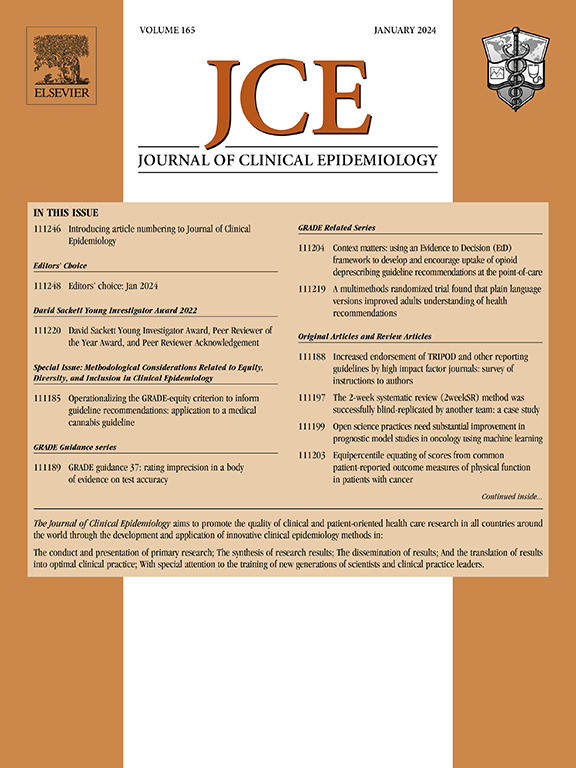Capturing the influx of living systematic reviews: a systematic methodological survey
IF 5.2
2区 医学
Q1 HEALTH CARE SCIENCES & SERVICES
引用次数: 0
Abstract
Objectives
Living systematic reviews (LSRs) are an emerging type of review that continuously updates as new evidence becomes available. A previous methodological survey conducted in 2021 identified and studied all health-based LSRs. Since then, the landscape has changed, including the on-going accumulation of COVID-19 research and availability of automation tools. Furthermore, various methods and guidance exist for conducting LSRs and review authors are often encouraged to explore opportunities to maximize dissemination. We conducted an LSR survey update to describe LSRs in a “post-COVID” era. Our objectives were to summarize the uptake of LSRs, describe their characteristics, including methodological and communicative characteristics, and identify patterns in LSR attributes.
Study Design and Setting
We systematically searched for new LSRs and any updates—including updates from LSRs identified previously—published between May 2021 and March 2023 in any health field. Eligible articles were identified and data extracted and combined with data from the original survey. Outcomes broadly included LSR characteristics and uptake, and methodological and communicative characteristics. Analyses were descriptive and included visualizations to explore distributions, combinations, and any time effects of characteristics.
Results
A total of 549 records across 168 individual LSRs were identified (of which 92 LSRs were newly detected). Although the presence of COVID-19 LSRs dominated in later years, there was an increased uptake in non–COVID-19 LSRs; the former were found to search the evidence and update/publish results more frequently. Where reported, the approach to conducting updates varied considerably, including a wide range of prespecified frequencies and/or triggers. Of the 337 updates, 25.5% reported on ongoing studies, and among LSRs with published results, 58.5% used the Grading of Recommendations, Assessment, Development and Evaluation system. The proportion of LSRs with a centralized platform for sharing results was higher among (i) those that included updates, (ii) Cochrane reviews, (iii) non–COVID-19 LSRs, and (iv) funded LSRs. Few LSRs included interactive features.
Conclusion
The number of LSRs is growing at an accelerating rate, but this survey illustrates that there are still methodological limitations and challenges that carefully need addressing. Key areas for improvement include more explicit prespecified updating strategies and better use of web-based platforms for disseminating results.
Plain Language Summary
Every year, a huge amount of health-related research is published and it is difficult for busy doctors and health care workers to keep up to date with all of the new evidence. To help with this, the research can be summarized by carrying out a review. This is known as a “systematic review” if it is carefully carried out by two or more researchers. We use systematic reviews to get an accurate and fair summary of all the research available. However, these reviews can take a long time to create and can quickly become out-of-date. There is a new and exciting type of review called a “LSR” which is continually updated with new research evidence as it becomes available. This type of review is hugely important for “high-priority” health questions that need to be put into practice straight away, such as new treatments for COVID-19. As LSRs have become more popular since the COVID-19 pandemic, it is important to understand how LSRs are actually being performed and how well they share their results. In 2021, a group of researchers collected all the health-related LSRs that exist. In March 2023, we aimed to collect any new LSRs since then, and summarize what they look like now. Including LSRs found by the previous group, we found 168 LSRs, where 92 were found since May 2021. There now exist more COVID-19-related LSRs than non–COVID-19-related ones, but both groups are increasing in popularity. How LSRs decided when to “update” their results varied a lot. Non–COVID-19-related LSRs and those that had funding were more likely to use online tools to share their results, but very few used tools to let readers interact with the results. By looking at how LSRs are performed, we have shown that there are still challenges that need more work. Key areas for improvement include creating better ways on deciding when and how these reviews should be updated, and building tools to help researchers summarize the findings in a way that is reliable and easily understandable to everyone involved, including patients.
捕捉大量的系统评论:一个系统的方法调查。
目的:动态系统评价(lsr)是一种新兴的评价类型,随着新证据的出现而不断更新。之前在2021年进行的一项方法学调查确定并研究了所有基于健康的低剂量饮食。自那时以来,形势发生了变化,包括COVID-19研究的持续积累和自动化工具的可用性。此外,存在各种方法和指南来进行lsr,并且通常鼓励综述作者探索最大化传播的机会。我们进行了LSR调查更新,以描述“后covid”时代的LSR。我们的目标是总结LSR的吸收,描述其特征,包括方法和交流特征,并确定LSR属性的模式。研究设计和设置:我们系统地检索了2021年5月至2023年3月期间在任何健康领域发表的新的lrs和任何更新-包括先前确定的lrs的更新。确定符合条件的文章,提取数据并与原始调查的数据相结合。结果广泛包括LSR特征和吸收,方法和交流特征。分析是描述性的,包括可视化来探索分布、组合和特征的任何时间效应。结果:共鉴定出168个lsr的549条记录(其中92条为新发现的lsr)。尽管在随后的几年中,COVID-19 lsr的存在占主导地位,但非COVID-19 lsr的摄取有所增加;前者被发现更频繁地搜索证据和更新/发布结果。在报告中,进行更新的方法差异很大,包括广泛的预先指定频率和/或触发器。在337次更新中,25.5%报告了正在进行的研究,而在已发表结果的lsr中,58.5%使用了GRADE系统。有集中平台共享结果的lsr比例较高,包括i)包含更新的lsr、ii) Cochrane综述、iii)非covid -19 lsr和iv)资助的lsr。很少有lsr包含交互功能。结论:lsr的数量正在加速增长,但这项调查表明,仍然存在方法上的局限性和挑战,需要认真解决。需要改进的关键领域包括更明确的预先规定的更新战略和更好地利用基于网络的平台传播结果。
本文章由计算机程序翻译,如有差异,请以英文原文为准。
求助全文
约1分钟内获得全文
求助全文
来源期刊

Journal of Clinical Epidemiology
医学-公共卫生、环境卫生与职业卫生
CiteScore
12.00
自引率
6.90%
发文量
320
审稿时长
44 days
期刊介绍:
The Journal of Clinical Epidemiology strives to enhance the quality of clinical and patient-oriented healthcare research by advancing and applying innovative methods in conducting, presenting, synthesizing, disseminating, and translating research results into optimal clinical practice. Special emphasis is placed on training new generations of scientists and clinical practice leaders.
 求助内容:
求助内容: 应助结果提醒方式:
应助结果提醒方式:


